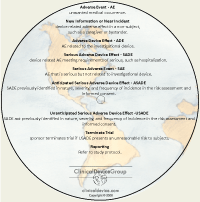
| Stark NJ, Adverse Event Wheel, Clinical Device Group Inc, Chicago, IL 2008. Waterproof plastic paper. $15.00 USD. |
Here are abbreviated definitions of adverse events and effects, designed for you to make a quick, preliminary classification in the clinic room or the meeting room. Although abbreviated, the definitions are in compliance with the international standard ISO 14155 and the US regulations CFR Part 812.
The wheel works by asking a series of questions with yes or no answers. It begins from the vantage point of the subject reporting a observation to the investigator (I fell, I'm feverish), or the investigator making a clinical observation about the subject (the subject's blood pressure is high).
Subject-Reported or Investigator-Observed Occurrances
[1] AE:The observation is an unwanted medical occurrance and is thus is initially an adverse event . A wanted medical occurrance is not adverse.
[2] The unwanted medical occurrance is device related and is therefore an adverse effect, but it occurred in a non-subject such as the investigator, a caregiver or a bystander. These observations are New Information or Near Incidents and may be reportable.
[3] ADE: The unwanted medical occurance is related to the investigational medical device, be it device failure, inadequate instructions-for-use, or investigator error, the occurance is an adverse device effect. "Effects" are related to investigational devices (as in cause and effect), while "events" are related to investigational drugs or biologics.
[4] SADE: The device related adverse effect meets the requirements of serious, such as hospitalization, and is a serious adverse device effect .
[5] SAE: The serious unwanted medical occurrance is not related to the investigational medical device, hence it is merely a serious adverse event.
[6]
ASADE: The serious unwanted medical device effect was anticipated, i.e., it was identified in nature, severity, and frequency of incidence in the risk assessment of the protocol and the informed consent.
[7] USADE: The serious unwanted medical device effect was not previously anticipated in the protocol's risk assessment and the informed consent. These effects are known as unanticipated serious adverse device effects.
[8] Trial Termination: Both US and EU regulations require termination of an investigation if the risk to subjects is unreasonable.
[9] Reporting: Reporting requirements depend on the protocol. Some protocols are written such that inevitable adverse events, say a scar following surgery, need not be reported.